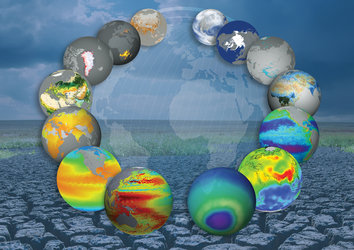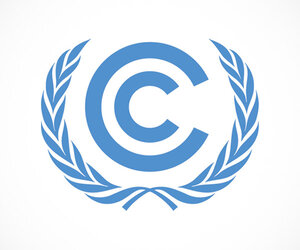Space agencies join forces to systematically observe climate variables
Over 30 000 people from 190 nations are gathered at the two-week UN Climate Change Conference in Copenhagen. On Thursday about 150 distinguished guests attended an ESA-hosted side event entitled 'Global Monitoring of our Climate: the Essential Climate Variables'.
During the event, speakers from various agencies highlighted the role that Earth observation satellites play in providing systematic global climate observations. These observations are essential for climate change research and for managing mitigation and adaptation strategies.
The UN Framework Convention on Climate Change (UNFCCC) has long recognised the need for global observations of climate variables in order to quantify the state of our climate. Within ESA’s Climate Change Initiative a set of long-term global records of essential climate variables will be provided using space technology.
These data are required by the Global Climate Observing System (GCOS) – an organisation in the framework of the World Meteorological Organization (WMO) – to support the UNFCCC and the International Panel on Climate Change.

Opening the side event, Dr Stephen Briggs, ESA’s Head of Earth Observation Science, Applications and Future Technologies Department, explained how ESA is responding to the needs of UNFCCC with its new Climate Change Initiative.
"ESA has developed the Climate Change Initiative to generate, preserve and give access to long-term data sets of the essential climate variables and make them freely available to climate research and modelling communities worldwide," Briggs said.
The initiative will build on the availability of Europe’s global data sets and on data delivered by a network of other space agencies. It will also guarantee the provision of space-based information for the future, in a form readily usable by scientific communities and government bodies.
Data from ESA satellites going back three decades, combined with data from new missions, will be used to produce information on a wide range of climate variables such as greenhouse-gas concentrations, sea-ice extent and thickness, and sea-surface temperature and height.
The Climate Change Initiative will implement all actions necessary to generate essential climate variables, including long-term data preservation, periodic reprocessing of the long-term climate archive, recalibration, algorithm development, product generation and validation, and quality assessment of climate records in the context of climate models.
These activities will be implemented by ESA, in partnership with key users (GCOS, UNFCCC), space agencies, relevant players in the field of climate change research and monitoring (EC, WMO, NOAA (the National Oceanic and Atmospheric Administration), EUMETSAT and national programmes).
At the event, Gilberto Camara, Director of the Brazilian Institute for Space Research (INPE) and CEOS Chair, described how space agencies are supporting climate observations in areas like greenhouse-gas and forest monitoring.
"Operational monitoring of climate using Earth observation is essential. This cannot be done alone. Therefore, there is a need for space agencies to coordinate and work together," Camara said. "Earth observation is the area that has increased the most in terms of budgets in the last few years and will increase more in the years to come. The 'data democracy' needs to reach the masses."

Carolin Richter, Director of GCOS Secretariat, also underscored the need for getting data to developing countries, saying she would like to see the objective for the free exchange of data achieved.
ESA’s Head of the Earth Observation Projects Section, Olivier Arino, presented the Agency’s fleet of Earth-observing satellites, including the Earth Explorers and Sentinels, and explained how data from these can contribute to studies on the global carbon cycle, sea-level height and temperatures and sea ice. He also demonstrated how satellites are being used for fire and ocean-colour monitoring.
Chairing the event, Briggs was on hand to recount ESA’s activities on monitoring forests, which were developed as part of the GMES (Global Monitoring for Environment and Security) services. The Forest Monitoring project was initiated to help establish a mechanism for measuring deforestation. A reliable procedure for validated, verified monitoring of forests, based on satellite data, will be needed to underpin any political agreement on schemes such as Reducing Emissions from Deforestation and Forest Degradation (REDD) under the UNFCCC.
Under REDD, countries that are willing and able to reduce emissions from deforestation would be financially compensated for doing so. Previous approaches to curb global deforestation have so far been unsuccessful, however, REDD provides a new framework to allow deforesting countries to break this historical trend.
European Environmental Agency Director Jacqueline McGlade spoke at the event about the impacts of climate change, giving the need to monitor the speed at which glaciers are changing as an example. "Political decision-makers count money; we will make them count water, clean air and forests. It is very important to have updated observations and long-term continuity of data. Climate change impact is a reality. Space tells us a great deal and being on the ground tells us even more. The combination of the two is essential."















 Germany
Germany
 Austria
Austria
 Belgium
Belgium
 Denmark
Denmark
 Spain
Spain
 Estonia
Estonia
 Finland
Finland
 France
France
 Greece
Greece
 Hungary
Hungary
 Ireland
Ireland
 Italy
Italy
 Luxembourg
Luxembourg
 Norway
Norway
 The Netherlands
The Netherlands
 Poland
Poland
 Portugal
Portugal
 Czechia
Czechia
 Romania
Romania
 United Kingdom
United Kingdom
 Slovenia
Slovenia
 Sweden
Sweden
 Switzerland
Switzerland



































